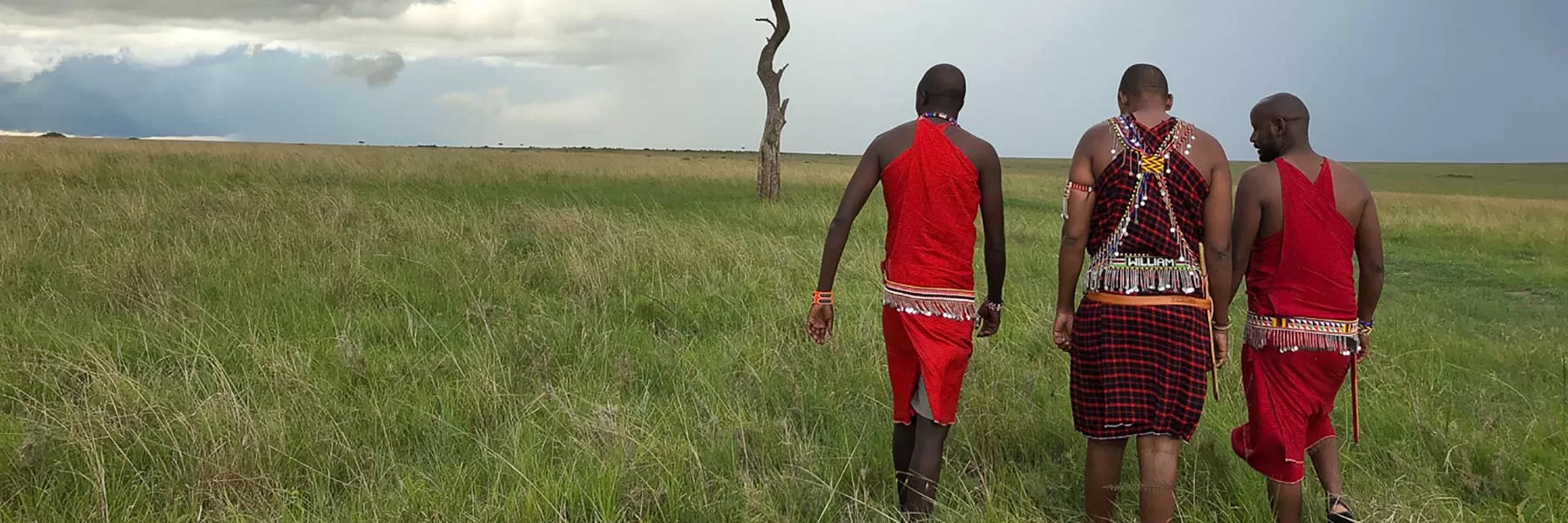Among the numerous tribes in Africa, the Maasai tribe is a Nilotic ethnic group that is indigenous to the Nile Valley. The Maasai tribe is prominent due to its colorful culture and traditions. This ethnic group comprises semi-nomadic people that have settled in northern, central, and southern Kenya, as well as northern Tanzania. The group resides near several national parks spread across East Africa. They are well-known because of their links to the reserves and the national parks.

The traditional Maasai tribe
The Maasai are one of the most traditionally distinctive tribes in Africa. They are easily recognizable for their cultural red robes and colorful beaded jewelry. They are known to be fearless warriors, practicing calm and courageous behavior as well as being highly regarded for their physique. The Maasai speak the Maa language, but most converse in Swahili as well.
The Maasai tribe has lived and looked after their land for hundreds of years. It is enlightening to learn about the indigenous Maasai and their origins before embarking on safari experiences in Kenya and Tanzania.
The Settlement in East Africa
According to the group’s oral traditions, the Maasai were originally a Nilo-Saharan tribe centered around the area that is today called Sudan. Between the 17th and 18th centuries, they arrived from the lower Nile Valley on a landmass that stretched from present-day northern Kenya to central Tanzania. The Maasai territory reached its maximum size in the 19th century, covering most of the Great Rift Valley and the neighboring lands of Mount Marsabit and Dodoma. During that time, they were part of the larger Nilotic group and raised cattle until the Tanga coast in the east of Tanganyika, now referred to as mainland Tanzania.

The southwestern landscape of Kenya
In 1852, there was a report stating that a concentration of approximately 800 Maasai warriors moved into Kenya. They continued to expand their domain in the areas of Lake Victoria and Mount Kilimanjaro by sending their younger generations to settle in new pastures. They continued this practice, looking for vacant or empty lands with a low existing population. As many other tribes started filling up East Africa, competition increased, and the Maasai were forced to fight for their rights to raise cattle in specific areas. They used spears and shields but were most feared for throwing clubs (orinka), which could be thrown precisely from up to 100 meters.
As they migrated, the Maasai became well-adapted to their new environment. Observers noticed irregular rainfall in the inland zones of Tanzania and Kenya, which prompted the Maasai to focus on stock-raising.
The period of expansion of the Maasai, also called ‘Emutai’, commenced in 1883 and ended in 1902. Epidemics of smallpox, a contagious and deadly disease, marked the Maasai tribe, affecting them significantly. Rinderpest killed 90 percent of the cattle and half of the wild species. The already difficult years coincided with droughts, during which rainfall ceased in 1897 and 1898.

A Maasai man in Tanzania
The development of modern Africa brought European settlers to the continent. Before their arrival, the Maasai continued to thrive on fertile lands. However, after failing to preserve their territory from the settlers, the tribe signed the first agreement in 1904, which let them lose their best lands to the Europeans. In 1911, seven years later, a small group of Maasai groups signed a controversial treaty where they gave up their northern land, Laikipia, to the settlers. The Maasai land in Kenya was cut down to almost 60 percent as the British evicted them. The Maasai people of Kenya were thus confined to the present-day Kajiado and Narok districts.
The authorities in Tanzania forced the Maasai groups out of their fertile lands between Mount Meru and Mount Kilimanjaro. During the 1940s, they compelled them to leave the mountainous regions near Ngorongoro. They claimed more land to build national parks and reserves. As a consequence of these two treaties, the Maasai lost two-thirds of their lands. And they were relocated to less fertile areas of Kenya and Tanzania.
While other tribes have adapted to fit in modern Africa, the Maasai have staunchly denied this change. They have resisted giving up their traditional lifestyle, as urged by the Kenyan and Tanzanian authorities. In Tanzania and Kenya, there has been a demand for the right to pasteurize and graze within several national parks.
The Maasai Religion
The Maasai tribe is monotheistic, which means they only believe in one God. The deity, Enkai or Engai, has a dual nature: Engai Narok is the ‘Black God’ that is benevolent, while Engai Na-nyokie is the ‘Red God’, known for being vengeful.

The Maasai people perform a ritual
The tribe also has two pillars or totems of Maasai society: Oodo Mongi, or the Red Cow; Orog Kiteng, or the Black Cow; and a subdivision of family trees, or five clans. The laibon is the central human figure in the Maasai religion who performs the roles of prophecy, divination, and shamanistic healing. The tribe considers the lion a totemic animal that people can kill. However, unlike trophy hunting, the Maasai usually hunted a lion for the rite of passage ceremony. This has become an activity of the past, as lion hunting is now completely banned in East Africa.
The Maasai Society
The Maasai society is strictly patriarchal in nature. The elder men, sometimes joined by retired leaders, determine most matters for the Maasai tribe. The traditional Maasai lifestyle focuses on livestock, which is a further indicator of prosperity and status. The cattle owned by the tribe fulfill the needs of each individual.
As a primary source of food, they eat meat as well as drink the blood of slaughtered animals on certain occasions. During special ceremonies, they eat the meat of Bulls, Goats, and Lambs. However, as the cattle are dwindling, the Maasai have turned to food such as sorghum, rice, potatoes, and cabbages.

A Maasai child with livestock
Long before the creation of national parks and reserves, the Maasai employed a sustainable approach to land management. They grazed their herds throughout the Rift Valley without causing any damage to the wildlife. The group migrated seasonally across large territories, leaving enough time to recover before coming back to graze them again. They disapproved of agriculture, believing that it would ruin the land meant for grazing. The Maasai did not kill any animals and relied on their herds for food.
Bead working
Beadwork has a long history of its own, as practiced by the Maasai women. They represent their identity and position in society through body painting and body ornaments. Before the arrival of the Europeans, people produced beads from local raw materials such as bone, ivory, clay shells, seeds, charcoal, ivory, brass, and more.

Maasai women adorned in ethic bead jewelry
In the late 19th century, brightly colored European glass beads arrived in Southeast Africa and replaced the older beads.
The Maasai Shelter
The Maasai have continually relied on local and readily available materials to construct their houses. Without any elaborative setup, the tribe’s house was impermanent in nature as they would move around often.

A Maasai shelter
Mostly constructed by Maasai women, the houses are rectangular or circular in shape. Men built enkang, or fences, to protect the livestock from wild animals surrounding the villages.
The Maasai Warriors
The Maasai, being pastoralists, are also considered warriors. In the past, various tribal groups clashed with each other, including the Maasai, for land and resources. The Laibons controlled and guided the Maasai warriors, or moran. These warriors lived a distinctive life within the tribe. They resided and traveled together in groups, trained and improved their physiques by fighting mock battles, and hunted lions to display their courage. They wore vivid red dresses and short capes and grew their hair long and often wore a beaded belt attached to a short knife and, occasionally, a beautiful ostrich feather headdress.

Maasai warriors perform Adamu
One of the most famous war dances of the Moran is jumping up and down on the spot, or the Adamu. In this ritual, the warriors gather in a semicircle and chant rhythmically in unison. Then, each steps out in front of the group and jumps several times in the air, as high as possible. Young Maasai warriors perform this war dance, showcasing a display of strength, while Maasai women carefully observe it.
The Maasai Mara
The Maasai Mara National Reserve is a large area of preserved savannah wilderness in Southwest Kenya, along the Tanzania border. The people of Maasai, who are the ancestral inhabitants of the land, honor it with their name. In the local Maasai language, the word ‘mara’ denotes spotted and refers to short, bushy trees that people see in the landscape.

Maasai people in the Maasai Mara Reserve
Maasai Mara was established in 1941 and has become one of the most popular parks in Africa, celebrated for its abundant wildlife population as well as the Maasai culture. The tribe still has permission to graze their livestock in specific parts of the reserve. Visitors can enjoy authentic cultural interactions in the Maasai Mara. The Maasai people, who are experts on the land and know all the secrets of the wildlife, conduct many of the safaris and game viewings. Maasai people living near the Serengeti and the Ngorongoro area are generous and welcoming as they share their culture and wisdom with visitors.
The Maasai tribe has managed to reject the modern practices of the world and continue to follow their long-established lifestyle. Various East African lodges, camps, and safaris support the Maasai tribe and help them economically, as well as educate visitors about their heritage.
If you loved reading this story, then subscribe to our blog here (it will ask to verify your email) to get inspiring travel stories and trivia delivered to your email. Stories about wildlife trivia, cultural experiences, curated luxury hotel lists, underrated places to travel, polar journeys and much more.











